2015 NISSAN LEAF tow
[x] Cancel search: towPage 3 of 39
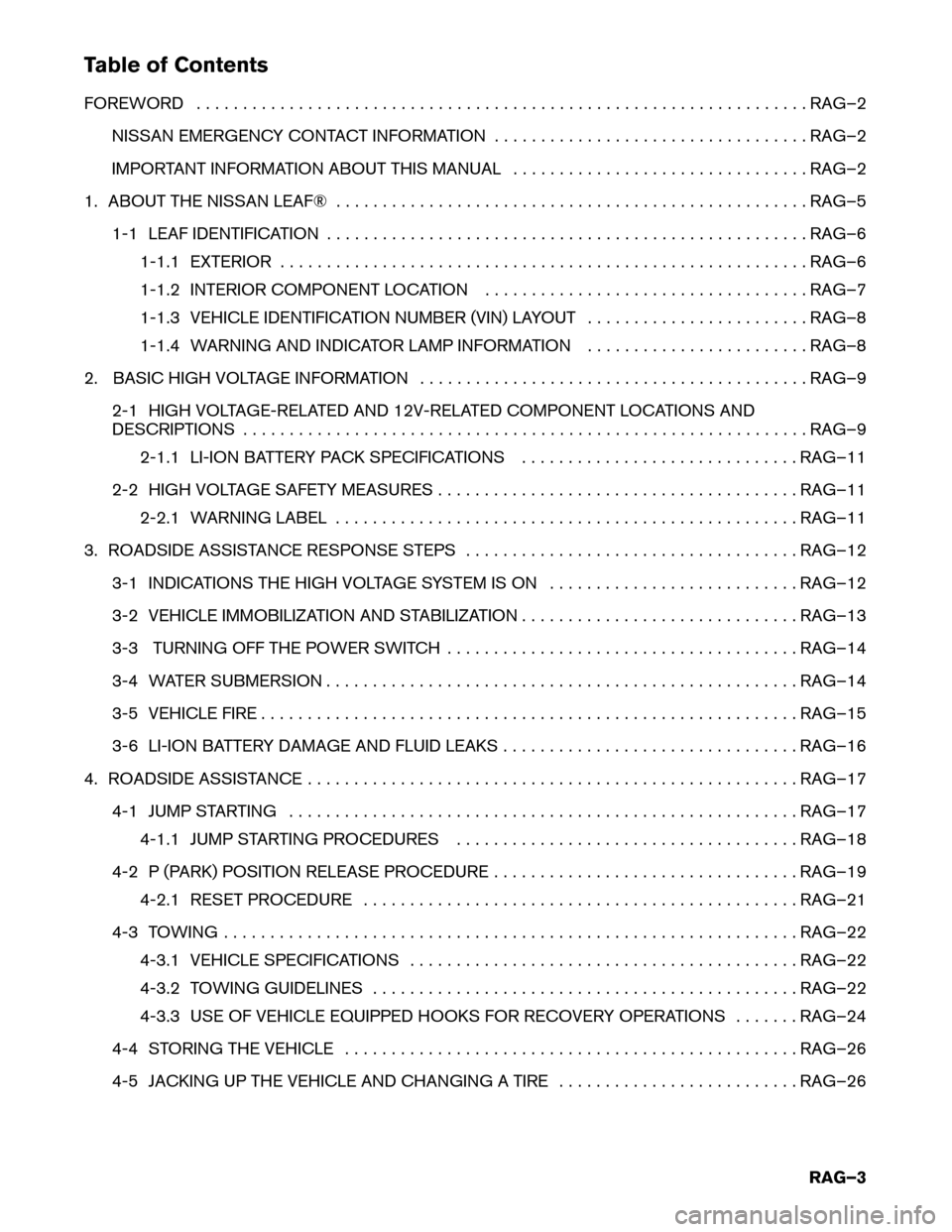
Table of Contents
FOREWORD
. . . . . . . . . . . . . . . . . . . . . . . . . . . . . . . . . . . . . . . . . . . . . . . . . . . . . . . . . . . . . . . . . . RAG–2
NISSAN EMERGENCY CONTACT INFORMATION . . . . . . . . . . . . . . . . . . . . . . . . . . . . . . . . . . RAG–2
IMPORTANT INFORMATION ABOUT THIS MANUAL . . . . . . . . . . . . . . . . . . . . . . . . . . . . . . . . RAG–2
1. ABOUT THE NISSAN LEAF® . . . . . . . . . . . . . . . . . . . . . . . . . . . . . . . . . . . . . . . . . . . . . . . . . . . RAG–5
1-1 LEAF IDENTIFICATION . . . . . . . . . . . . . . . . . . . . . . . . . . . . . . . . . . . . . . . . . . . . . . . . . . . . RAG–6 1-1.1 EXTERIOR . . . . . . . . . . . . . . . . . . . . . . . . . . . . . . . . . . . . . . . . . . . . . . . . . . . . . . . . . RAG–6
1-1.2 INTERIOR COMPONENT LOCATION . . . . . . . . . . . . . . . . . . . . . . . . . . . . . . . . . . . RAG–7
1-1.3 VEHICLE IDENTIFICATION NUMBER (VIN) LAYOUT . . . . . . . . . . . . . . . . . . . . . . . . RAG–8
1-1.4 WARNING AND INDICATOR LAMP INFORMATION . . . . . . . . . . . . . . . . . . . . . . . . RAG–8
2. BASIC HIGH VOLTAGE INFORMATION . . . . . . . . . . . . . . . . . . . . . . . . . . . . . . . . . . . . . . . . . . RAG–9 2-1 HIGH VOLTAGE-RELATED AND 12V-RELATED COMPONENT LOCATIONS AND
DESCRIPTIONS . . . . . . . . . . . . . . . . . . . . . . . . . . . . . . . . . . . . . . . . . . . . . . . . . . . . . . . . . . . . . RAG–9 2-1.1 LI-ION BATTERY PACK SPECIFICATIONS . . . . . . . . . . . . . . . . . . . . . . . . . . . . . . RAG–11
2-2 HIGH VOLTAGE SAFETY MEASURES . . . . . . . . . . . . . . . . . . . . . . . . . . . . . . . . . . . . . . . RAG–11 2-2.1 WARNING LABEL . . . . . . . . . . . . . . . . . . . . . . . . . . . . . . . . . . . . . . . . . . . . . . . . . . RAG–11
3. ROADSIDE ASSISTANCE RESPONSE STEPS . . . . . . . . . . . . . . . . . . . . . . . . . . . . . . . . . . . . RAG–12
3-1 INDICATIONS THE HIGH VOLTAGE SYSTEM IS ON . . . . . . . . . . . . . . . . . . . . . . . . . . . RAG–12
3-2 VEHICLE IMMOBILIZATION AND STABILIZATION . . . . . . . . . . . . . . . . . . . . . . . . . . . . . . RAG–13
3-3 TURNING OFF THE POWER SWITCH . . . . . . . . . . . . . . . . . . . . . . . . . . . . . . . . . . . . . . RAG–14
3-4 WATER SUBMERSION . . . . . . . . . . . . . . . . . . . . . . . . . . . . . . . . . . . . . . . . . . . . . . . . . . . RAG–14
3-5 VEHICLE FIRE . . . . . . . . . . . . . . . . . . . . . . . . . . . . . . . . . . . . . . . . . . . . . . . . . . . . . . . . . . RAG–15
3-6 LI-ION BATTERY DAMAGE AND FLUID LEAKS . . . . . . . . . . . . . . . . . . . . . . . . . . . . . . . . RAG–16
4. ROADSIDE ASSISTANCE . . . . . . . . . . . . . . . . . . . . . . . . . . . . . . . . . . . . . . . . . . . . . . . . . . . . . RAG–17 4-1 JUMP STARTING . . . . . . . . . . . . . . . . . . . . . . . . . . . . . . . . . . . . . . . . . . . . . . . . . . . . . . . RAG–174-1.1 JUMP STARTING PROCEDURES . . . . . . . . . . . . . . . . . . . . . . . . . . . . . . . . . . . . . RAG–18
4-2 P (PARK) POSITION RELEASE PROCEDURE . . . . . . . . . . . . . . . . . . . . . . . . . . . . . . . . . RAG–19 4-2.1 RESET PROCEDURE . . . . . . . . . . . . . . . . . . . . . . . . . . . . . . . . . . . . . . . . . . . . . . . RAG–21
4-3 TOWING . . . . . . . . . . . . . . . . . . . . . . . . . . . . . . . . . . . . . . . . . . . . . . . . . . . . . . . . . . . . . . RAG–22 4-3.1 VEHICLE SPECIFICATIONS . . . . . . . . . . . . . . . . . . . . . . . . . . . . . . . . . . . . . . . . . . RAG–22
4-3.2 TOWING GUIDELINES . . . . . . . . . . . . . . . . . . . . . . . . . . . . . . . . . . . . . . . . . . . . . . RAG–22
4-3.3 USE OF VEHICLE EQUIPPED HOOKS FOR RECOVERY OPERATIONS . . . . . . . RAG–24
4-4 STORING THE VEHICLE . . . . . . . . . . . . . . . . . . . . . . . . . . . . . . . . . . . . . . . . . . . . . . . . . RAG–26
4-5 JACKING UP THE VEHICLE AND CHANGING A TIRE . . . . . . . . . . . . . . . . . . . . . . . . . . RAG–26
RAG–3
Page 14 of 39
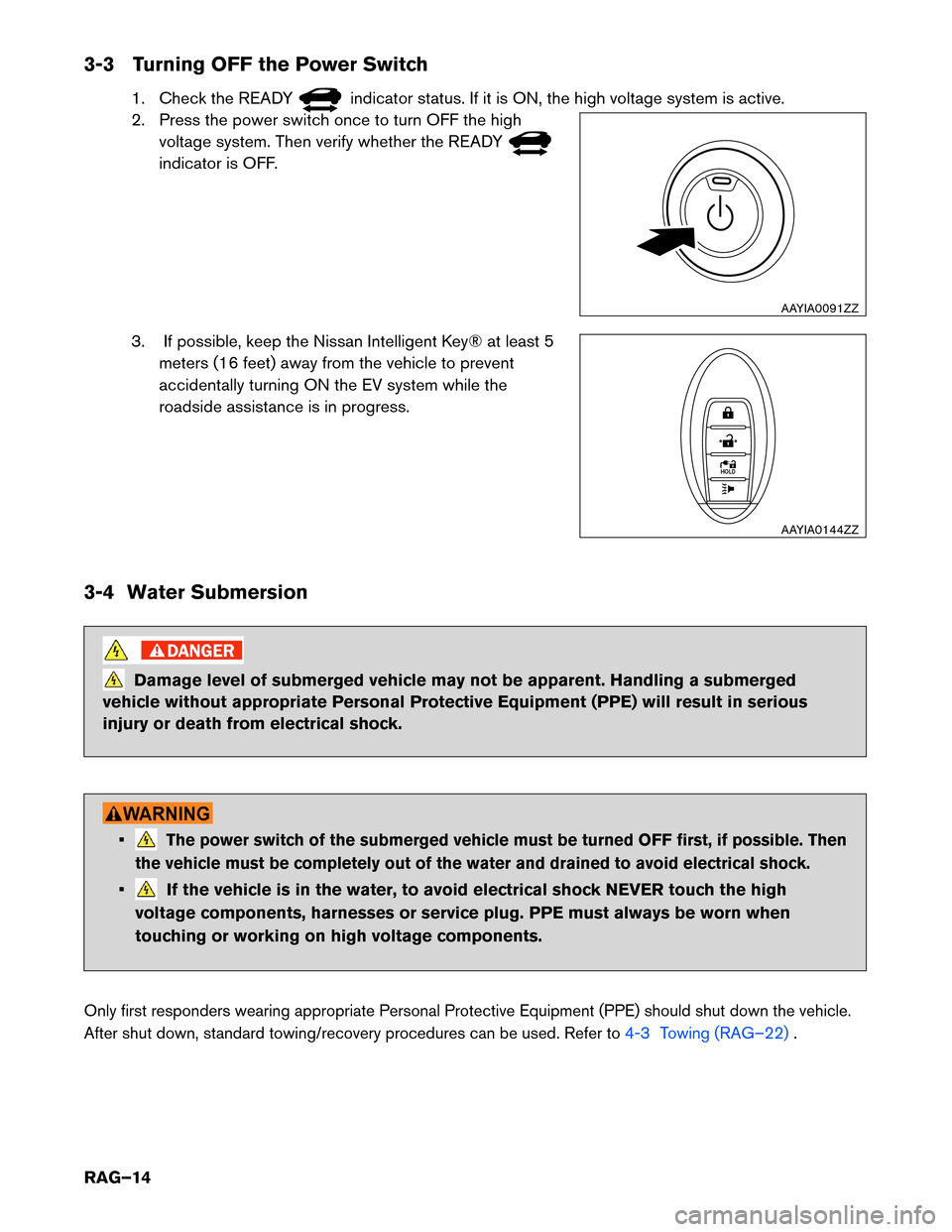
3-3 Turning OFF the Power Switch
1. Check the READY indicator status. If it is ON, the high voltage system is active.
2.
Press the power switch once to turn OFF the high
voltage system. Then verify whether the READY indicator is OFF.
3.
If possible, keep the Nissan Intelligent Key® at least 5
meters (16 feet) away from the vehicle to prevent
accidentally turning ON the EV system while the
roadside assistance is in progress.
3-4 Water Submersion Damage level of submerged vehicle may not be apparent. Handling a submerged
vehicle
without appropriate Personal Protective Equipment (PPE) will result in serious
injury or death from electrical shock. •
The power switch of the submerged vehicle must be turned OFF first, if possible. Then
the vehicle must be completely out of the water and drained to avoid electrical shock.
• If the vehicle is in the water, to avoid electrical shock NEVER touch the high
voltage components, harnesses or service plug. PPE must always be worn when
touching or working on high voltage components.
Only first responders wearing appropriate Personal Protective Equipment (PPE) should shut down the vehicle.
After shut down, standard towing/recovery procedures can be used. Refer to 4-3 Towing (RAG–22)
. AAYIA0091ZZ
HOLD
AAYIA0144ZZ
RAG–14
Page 22 of 39
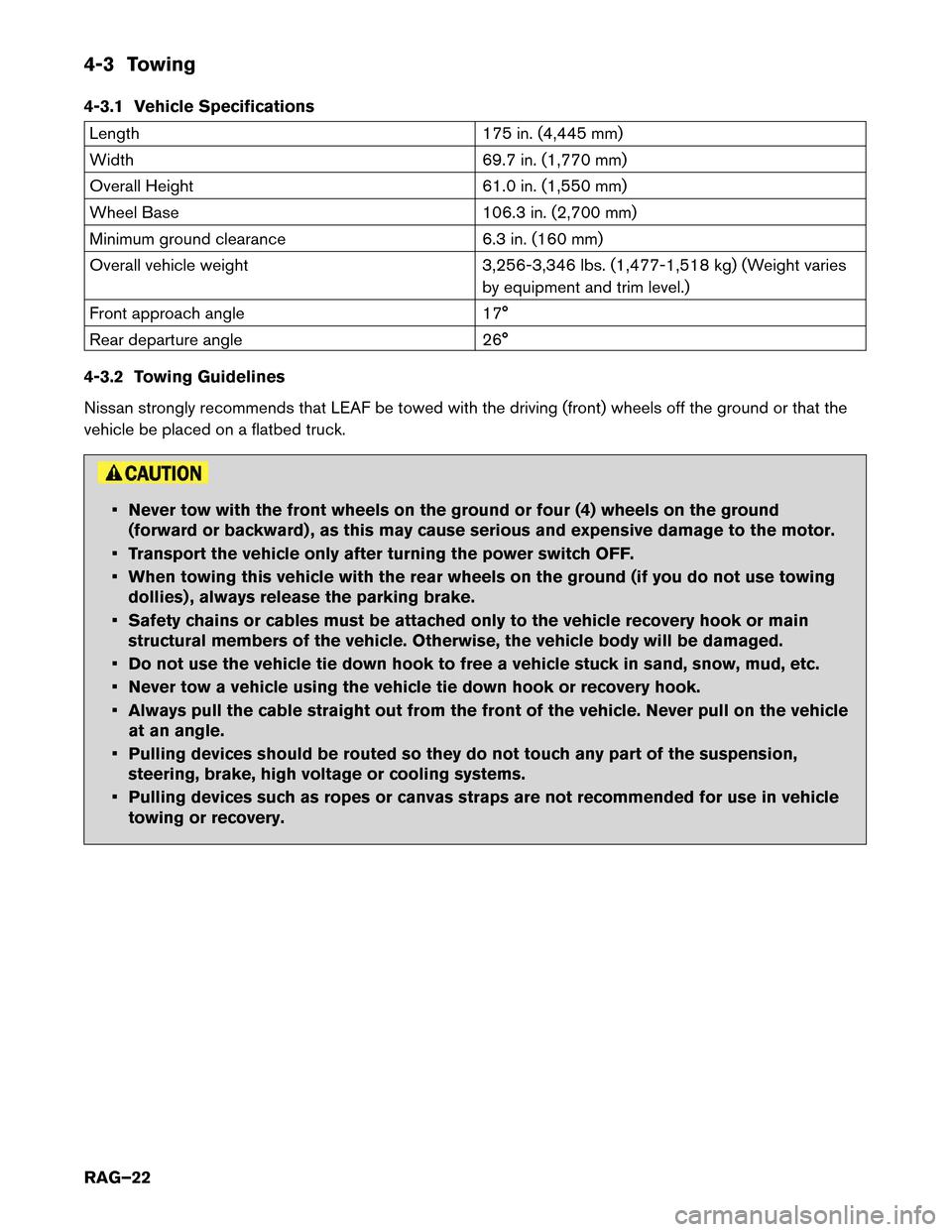
4-3 Towing
4-3.1
Vehicle Specifications Length
175
in. (4,445 mm)
Width 69.7 in. (1,770 mm)
Overall Height 61.0 in. (1,550 mm)
Wheel Base 106.3 in. (2,700 mm)
Minimum ground clearance 6.3 in. (160 mm)
Overall vehicle weight 3,256-3,346 lbs. (1,477-1,518 kg) (Weight varies
by equipment and trim level.)
Front approach angle 17°
Rear departure angle 26°
4-3.2 Towing Guidelines
Nissan strongly recommends that LEAF be towed with the driving (front) wheels off the ground or that the
vehicle be placed on a flatbed truck. • Never tow with the front wheels on the ground or four (4) wheels on the ground
(forward
or backward) , as this may cause serious and expensive damage to the motor.
• Transport the vehicle only after turning the power switch OFF.
• When towing this vehicle with the rear wheels on the ground (if you do not use towing dollies) , always release the parking brake.
• Safety chains or cables must be attached only to the vehicle recovery hook or main structural members of the vehicle. Otherwise, the vehicle body will be damaged.
• Do not use the vehicle tie down hook to free a vehicle stuck in sand, snow, mud, etc.
• Never tow a vehicle using the vehicle tie down hook or recovery hook.
• Always pull the cable straight out from the front of the vehicle. Never pull on the vehicle at an angle.
• Pulling devices should be routed so they do not touch any part of the suspension, steering, brake, high voltage or cooling systems.
• Pulling devices such as ropes or canvas straps are not recommended for use in vehicle towing or recovery.
RAG–22
Page 23 of 39
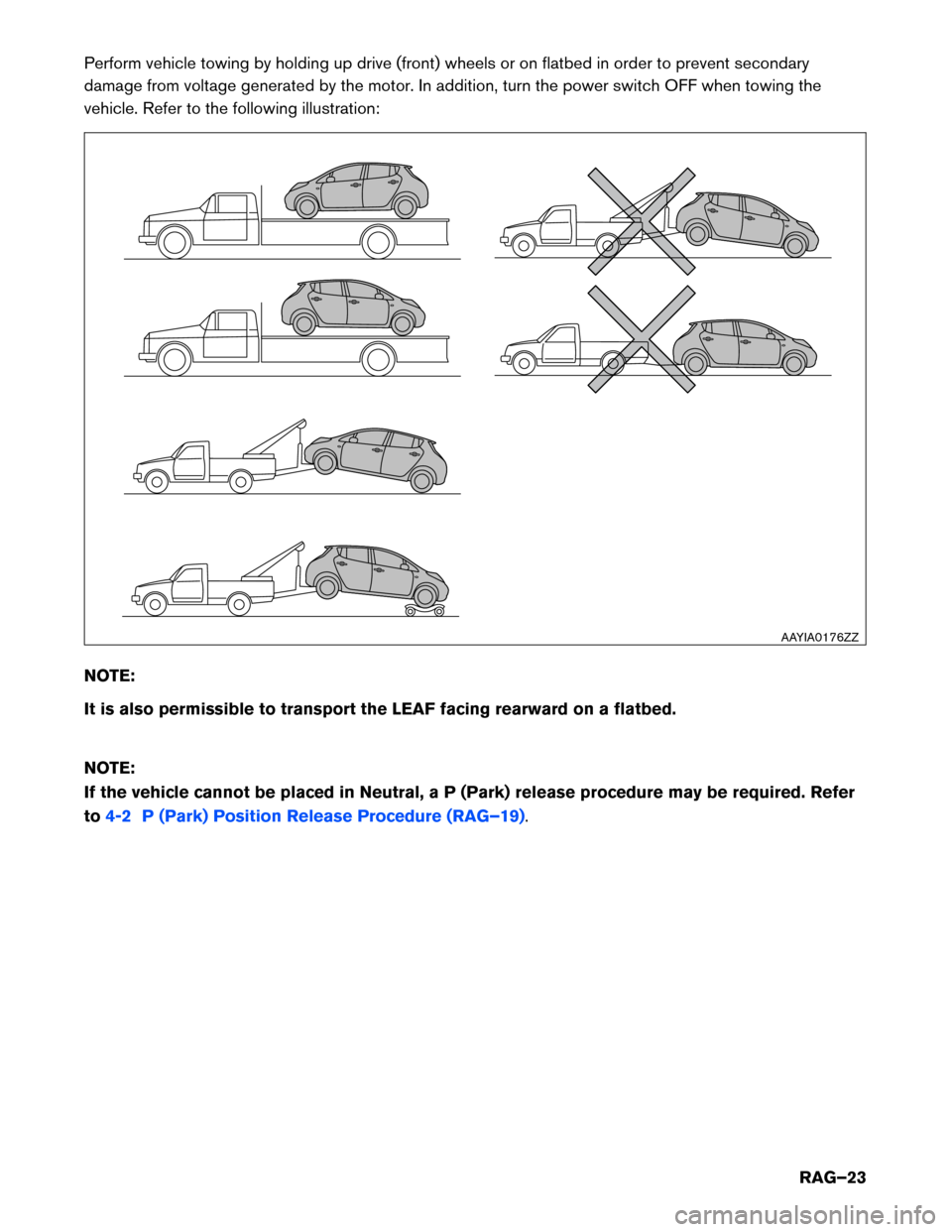
Perform vehicle towing by holding up drive (front) wheels or on flatbed in order to prevent secondary
damage
from voltage generated by the motor. In addition, turn the power switch OFF when towing the
vehicle. Refer to the following illustration:
NOTE:
It is also permissible to transport the LEAF facing rearward on a flatbed.
NOTE:
If the vehicle cannot be placed in Neutral, a P (Park) release procedure may be required. Refer
to 4-2 P (Park) Position Release Procedure (RAG–19). AAYIA0176ZZ
RAG–23
Page 26 of 39
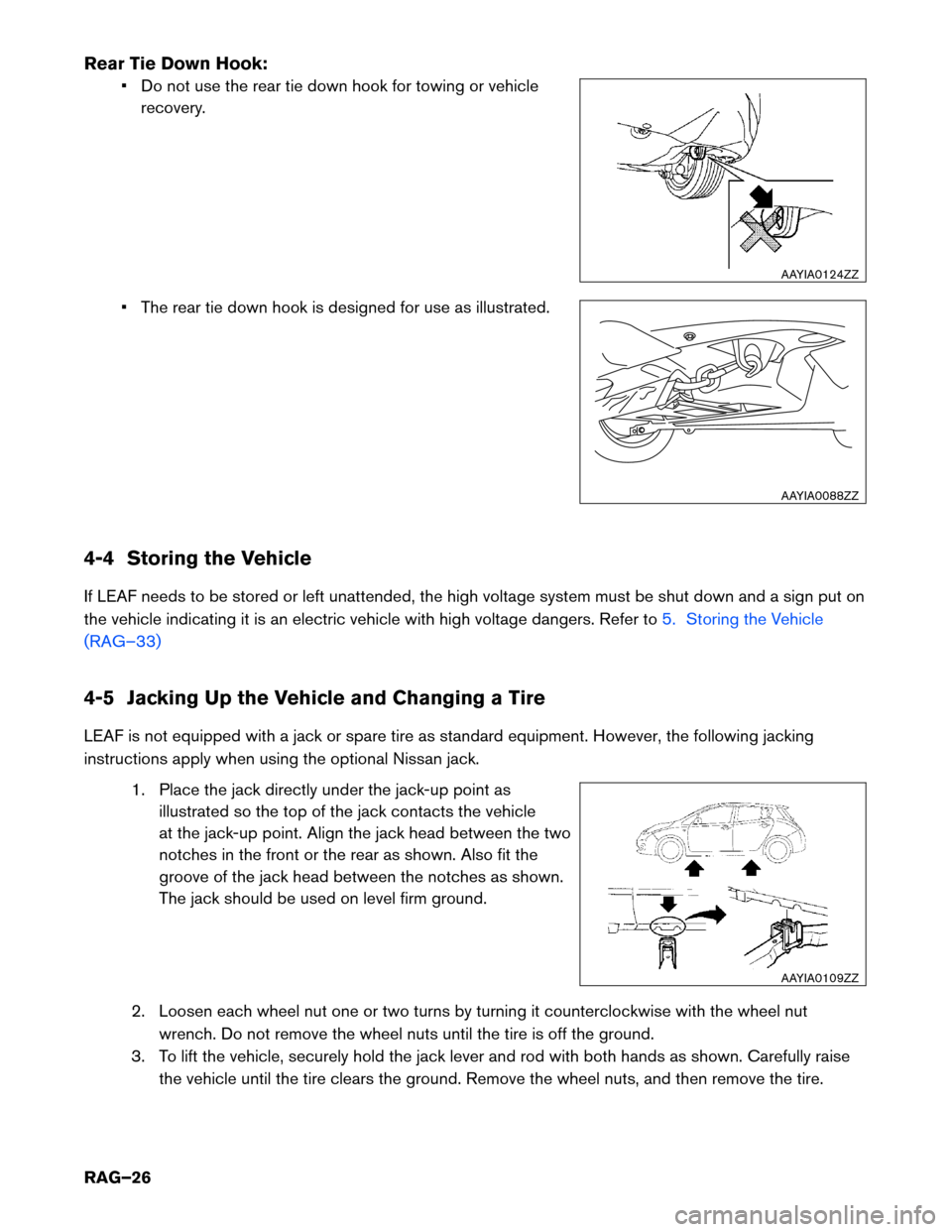
Rear Tie Down Hook:
• Do not use the rear tie down hook for towing or vehicle
recovery.
• The rear tie down hook is designed for use as illustrated.
4-4 Storing the Vehicle
If LEAF needs to be stored or left unattended, the high voltage system must be shut down and a sign put on
the vehicle indicating it is an electric vehicle with high voltage dangers. Refer to 5. Storing the Vehicle
(RAG–33)
4-5 Jacking Up the Vehicle and Changing a Tire
LEAF
is not equipped with a jack or spare tire as standard equipment. However, the following jacking
instructions apply when using the optional Nissan jack.
1. Place the jack directly under the jack-up point asillustrated so the top of the jack contacts the vehicle
at the jack-up point. Align the jack head between the two
notches in the front or the rear as shown. Also fit the
groove of the jack head between the notches as shown.
The jack should be used on level firm ground.
2. Loosen each wheel nut one or two turns by turning it counterclockwise with the wheel nut wrench. Do not remove the wheel nuts until the tire is off the ground.
3. To lift the vehicle, securely hold the jack lever and rod with both hands as shown. Carefully raise the vehicle until the tire clears the ground. Remove the wheel nuts, and then remove the tire. AAYIA0124ZZ
AAYIA0088ZZ
AAYIA0109ZZ
RAG–26
Page 31 of 39

5. Remove the protective cap (A) of the hose and screw
the hose securely onto the tire valve. Make sure that the
pressure release valve (B) is securely tightened. Make
sure that the air compressor switch is in the OFF (O)
position and then insert the power plug into the power
outlet in the vehicle.
6. Push the vehicle power switch to the ACC position.
7. Turn the air compressor switch to the ON (-) position and inflate the tire up to the pressure that is specified on
the tire and loading information label affixed to the
driver’s side center pillar if possible or to the minimum of
26 psi (180 kPa) . Turn the air compressor off briefly in
order to check the tire pressure with the pressure gauge.
If the tire is inflated to higher than the specified pressure,
lower the tire pressure by releasing air with the pressure
release valve.
NOTE:
The compressor tire gauge may show a pressure reading of 87 psi (600 kPa) for about
30 seconds while inflating the tire. The pressure gauge is indicating the pressure
inside the sealant bottle. When the sealant has been injected into the tire the
pressure gauge will drop and indicate actual tire pressure. • To avoid serious personal injury while using the emergency tire puncture repair kit:
–
Securely tighten the compressor hose to the tire valve. Failure to do so can cause the
sealant to spray into the air and get into your eyes or on your skin.
– Do not stand directly beside the damaged tire while it is being inflated because of the risk of rupture. If there are any cracks or bumps in the tire, turn the compressor OFF
immediately.
If the tire pressure does not increase to 26 psi (180 kPa) within ten (10) minutes, the tire may be
seriously damaged and the tire cannot be repaired with this tire repair kit.
Contact a NISSAN certified LEAF dealer. 8. When the tire pressure is at the specified amount, turn the air compressor OFF. If the tire cannotbe inflated to the specified amount, the air compressor can be turned OFF at the minimum of 26
psi (180 kPa) . Remove the power plug from the power outlet and quickly remove the hose from
the tire valve. Attach the protective cap and the valve cap. Securely stow the emergency tire
puncture repair kit in the cargo area. B
A
AAYIA0134ZZ AAYIA0135ZZ
RAG–31
Page 32 of 39
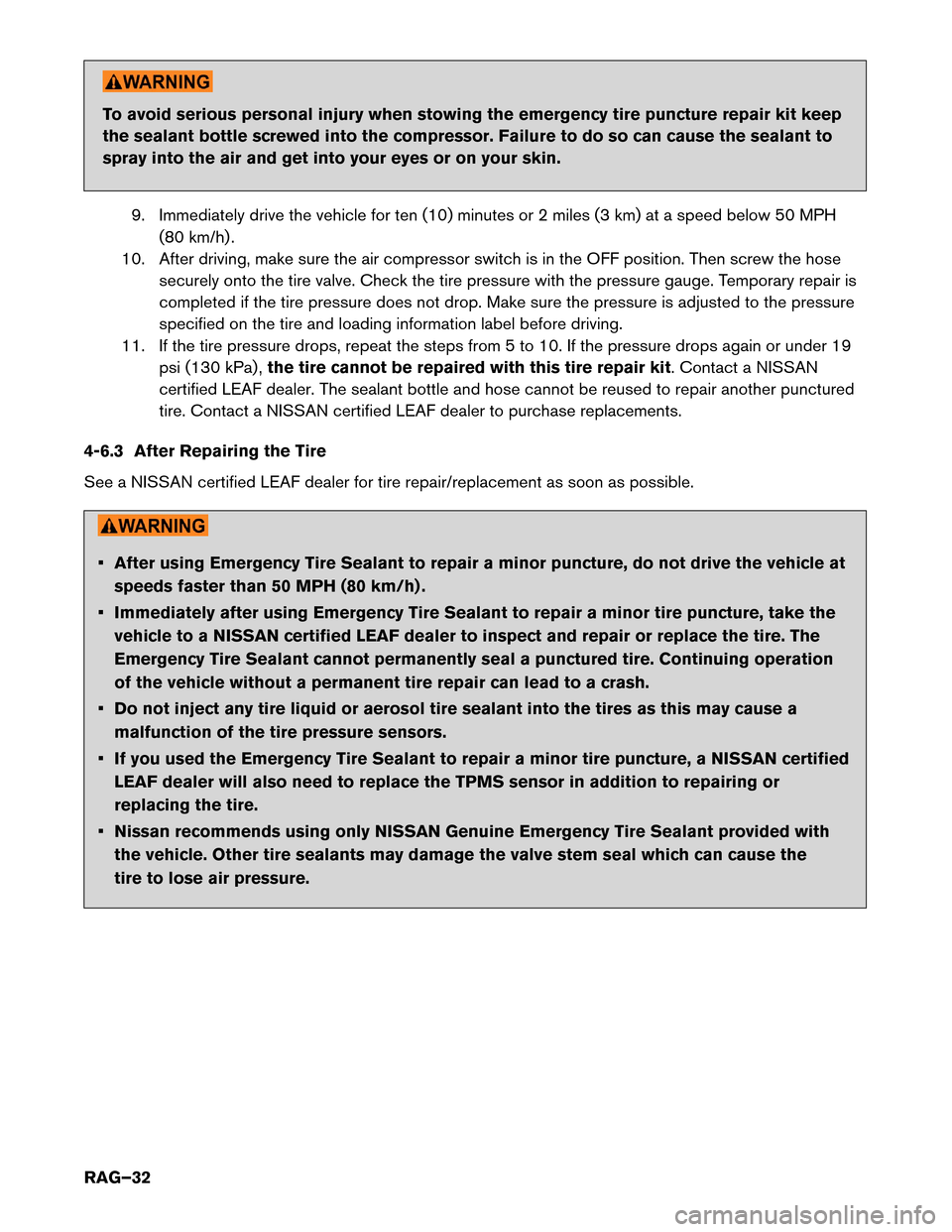
To avoid serious personal injury when stowing the emergency tire puncture repair kit keep
the
sealant bottle screwed into the compressor. Failure to do so can cause the sealant to
spray into the air and get into your eyes or on your skin.
9. Immediately drive the vehicle for ten (10) minutes or 2 miles (3 km) at a speed below 50 MPH(80 km/h) .
10. After driving, make sure the air compressor switch is in the OFF position. Then screw the hose securely onto the tire valve. Check the tire pressure with the pressure gauge. Temporary repair is
completed if the tire pressure does not drop. Make sure the pressure is adjusted to the pressure
specified on the tire and loading information label before driving.
11. If the tire pressure drops, repeat the steps from 5 to 10. If the pressure drops again or under 19 psi (130 kPa) , the tire cannot be repaired with this tire repair kit. Contact a NISSAN
certified LEAF dealer. The sealant bottle and hose cannot be reused to repair another punctured
tire. Contact a NISSAN certified LEAF dealer to purchase replacements.
4-6.3 After Repairing the Tire
See a NISSAN certified LEAF dealer for tire repair/replacement as soon as possible. • After using Emergency Tire Sealant to repair a minor puncture, do not drive the vehicle at
speeds
faster than 50 MPH (80 km/h) .
• Immediately after using Emergency Tire Sealant to repair a minor tire puncture, take the vehicle to a NISSAN certified LEAF dealer to inspect and repair or replace the tire. The
Emergency Tire Sealant cannot permanently seal a punctured tire. Continuing operation
of the vehicle without a permanent tire repair can lead to a crash.
• Do not inject any tire liquid or aerosol tire sealant into the tires as this may cause a malfunction of the tire pressure sensors.
• If you used the Emergency Tire Sealant to repair a minor tire puncture, a NISSAN certified LEAF dealer will also need to replace the TPMS sensor in addition to repairing or
replacing the tire.
• Nissan recommends using only NISSAN Genuine Emergency Tire Sealant provided with the vehicle. Other tire sealants may damage the valve stem seal which can cause the
tire to lose air pressure.
RAG–32